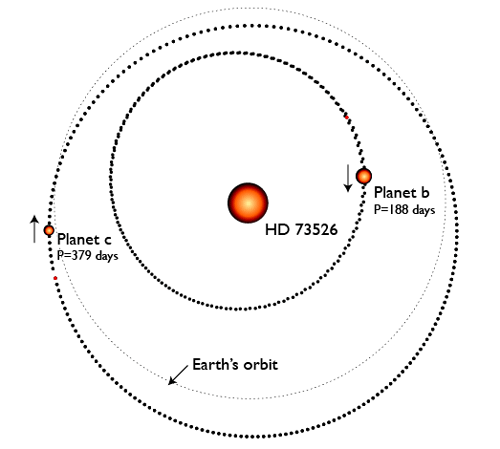A very interesting new planetary system has been discovered in orbit around the nearby star HD 73526, a solar-type main sequence dwarf visible from the Southern Hemisphere. The discovery was made by Chris Tinney, Paul Butler, Geoff Marcy and their collaborators on the Anglo Australian Planet Search Project. The discovery paper has been accepted by the Astrophysical Journal, and a preprint describing the discovery has been posted to arXiv.org.

[Photo of persimmons at Rakushisha, Kyoto, Japan, c2005 Adriane Steinacker]
The system contains two giant planets. The inner, slightly more massive planet (imaginatively named “b”) contains at least 3 Jupiter masses, and orbits with a 188 day period. The outer planet, c, is only slightly less massive, with about 2.5 Jupiter masses. It orbits with a period of roughly 379 days. Planet c is a true room temperature gas giant. Liquid water likely blows in gusty sheets across its cloudy skies. (And it’s worth noting that any large moons circling HD 73526 c lie pleasantly within the stellar habitable zone.)

The large masses of the two planets, and their relatively small orbital separation, indicate that they exert strong perturbations on each other’s motion. It appears that in order for the system to be stable, it is required that b and c exist in a protective 2:1 resonance. In other words, on average, planet c circles the parent star exactly half as many times as does planet b. Amazingly, however, it appears that the periastron points of the two orbits are not locked in sync, but rather circulate at very different rates around the star. This situation leads to a bizarre orbital motion when plotted over thousands of years. I’ve made an mpeg animation which shows how this works. In the animation, the clockhand like lines show the periastron angles of the orbits. They undergo a crazy, almost drunken, dance, but somehow, the system configuration manages to remain stable indefinitely.
I’ve also added the published radial velocity data for HD 73526 to the Systemic Console. Take a peek at the published orbital parameters (both Keplerian and dynamical) if you have a hard time rolling the Console’s Levenberg-Marquardt algorithm into the best-fit configuration. I will put up a post shortly which goes into more detail about the dynamics of this fascinating system and what they tell us about planetary formation.

Pingback: Centauri Dreams » Blog Archive » A Gas Giant in the Habitable Zone
Hi Greg
I noticed you said to Paul at Centauri Dreams that the magnetic environment of super-Jovians would probably be hostile to habitable moons. Wouldn’t a stronger magnetic field cause solar wind particles to have a smaller radius around the planet? Having said that I know Jupiter’s particle belts are bigger than Saturn’s so I must be missing something in my understanding.
If a Jovian has a higher mass than Jupiter would its equivalents of the Galilean moons form further out? Guess we won’t know until we can image them around other exoplanets.
Adam
Pingback: systemic - stop-action stop-gap